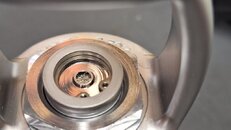You are using an out of date browser. It may not display this or other websites correctly.
You should upgrade or use an alternative browser.
You should upgrade or use an alternative browser.
Question Need help with an AL Titan
- Thread starter Sensorone
- Start date
Please register or login
Welcome to ScubaBoard, the world's largest scuba diving community. Registration is not required to read the forums, but we encourage you to join. Joining has its benefits and enables you to participate in the discussions.
Benefits of registering include
- Ability to post and comment on topics and discussions.
- A Free photo gallery to share your dive photos with the world.
- You can make this box go away
Not a yoke user so… I could be wrong
My guess is ACD (auto closure to prevent splashing when not threaded onto tank)
My guess is ACD (auto closure to prevent splashing when not threaded onto tank)
I came upon a nice Titan that has a strange (to me) part above the inlet filter. Never have seen this before on any of my Conshelfs. Any thoughts?
Looks like someone improvised on the washer that should be between the circlip and the filter. My recollection is that the washer didn’t have such a small centre opening.
I can’t recall if a replacement washer is in the service kit.
Earlier Titans did not have ACD.
No ACD on early Titan LX regulators. Whatever that is looks like farm technology to me. That regulator can use current kits for the Core/Helix minus the ACD parts.
Why people do weird s---t like that is beyond me.
Why people do weird s---t like that is beyond me.
Why people do weird s---t like that is beyond me.
That is the original part/design of the Titan 1st stage. There was an update that changed the washer because it was felt that the small diameter opening of the original washer made it difficult to inspect the sintered filter behind the washer without removing the snap ring and the washer.
-Z
Tanks A Lot
Contributor
Zef is correct, this brass washer was introduced in 2001 and replaced the old nylon washer. It was meant to improve Nitrox compatability.
In November 2005 the washer was replaced again to allow easier inspection of the filter as Zef mentions.
In November 2005 the washer was replaced again to allow easier inspection of the filter as Zef mentions.
Attachments
Thanks for the information. I will replace it with the updated spacer when I overhaul it. I am curious as to what drove the engineering decision to utilize such a strange spacer. The small orifice doesn't make much sense to me.
sorry, double post
That is the original part/design of the Titan 1st stage. There was an update that changed the washer because it was felt that the small diameter opening of the original washer made it difficult to inspect the sintered filter behind the washer without removing the snap ring and the washer.
-Z
Thanks, now that you mention it I may have seen that before. It certainly obscures casual inspection of the sintered filter.

Maybe AL got a deal on bunch of cheap washers or something and hated to let them go to waste, lol. I have seen the Nylon and replaced them right off.
Thanks for the information. I will replace it with the updated spacer when I overhaul it. I am curious as to what drove the engineering decision to utilize such a strange spacer. The small orifice doesn't make much sense to me.
There is nothing wrong with the washer with the narrow opening. If you receive the updated washer in a service kit and want to replace it, go for it, but there is no issue with continuing to use the one you have, and if the updated one is not in the service kit, there is no reason to source one unless you feel you "gotta have it". As was mentioned by @Tanks A Lot, the actual original part was a nylon/plastic washer that somehow posed a problem when using gas mixtures with elevated amounts of O2, perhaps it degraded the nylon washer, or perhaps it posed a combustion hazard...Aqualung made a change to stainless steel. Unfortunatelty, the vast diving public, especially those that rent gear, do not take very good care of their equipment and are not diligent when rinsing their gear to prevent water ingress at the first stage inlet. This prompted Aqualung to make the running change to the a washer with a more "normal" opening, so dive centers could more easily inspect the filter which tends to turn green with verdigris when contaminated with water, especially sea water. The next major advancement for this area of a 1st stage, though never incorporated in the model in question, was the ACD. The ACD, potentially, further protected the 1st stage from user carelessness by automatically closing the inlet when the 1st stage is removed from the tank valve.
-Z
Similar threads
- Replies
- 2
- Views
- 905
- Replies
- 3
- Views
- 801
- Replies
- 35
- Views
- 1,253
- Replies
- 11
- Views
- 684





